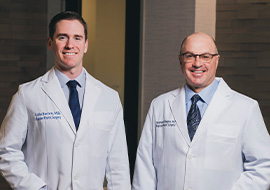Chalazion and Stye
What is a Chalazion?
A chalazion is a small or large bump in the eyelid caused by inflammation of one or more of the oil-producing, sebaceous glands (meibomian glands) located in the tarsal plates near the eyelashes in the upper and lower eyelids. The trapped oil secretions (sebum) may lead to inflammation, redness, swelling and sometimes discharge.
What is a Stye?
A stye is an acute infection of the sebaceous glands of the eyelid. They may occur internally (internal hordeolum) or externally (external hordeolum). Styes are much more uncomfortable than chalazia and may be more responsive to topical antibiotic treatment.
What are the Most Common Symptoms?
Swelling of the eyelid may be localized or involve the entire upper eyelid. There is often tenderness to touch over the area of the involved oil gland. Patients with chalazia and styes frequently have signs and symptoms of blepharitis including excessive matter and crusting on the eyelids upon awakening; a gritty feeling in the eyes; a burning sensation that is worse while reading, driving, watching T.V., or working at the computer. An oily and unstable tear film may result in dry, irritated, red eyes. Patients with acne rosacea have an increased incidence of chalazia.
How are Chalazia Treated?
Medical treatment is similar to the management of blepharitis including eyelid hygiene, eyelid scrubs, and warm compresses. Topical antibiotics are usually of limited help with chalazia but may be more useful with with hordeola (styes).
Warm Compresses and Soaks
The purpose of warm compresses is to open up the pores at the ends of the ducts where the glands drain onto the margins of the eyelids and ultimately into the eye. Warm compresses are warm or hot soaks placed over the closed eyelids. The best way to perform at least one of your warm compresses each day is to do so while in the shower. Turn the water temperature up a few degrees, place a face cloth across your eyes, turn your face toward the water stream, and allow your face and eyelids to soak in the warm water for five minutes or so (perhaps while you have conditioner soaking in your hair). Warm compresses should also be applied upon awakening and prior to going to bed. A dampened face cloth should be placed across the eyes for 5-10 minutes. The face cloth may need to be reheated with hot tap water after 3-4 minutes. Some individuals like to heat a dampened face cloth in the microwave. This may help retain the heat within the cloth; however this must be done with extreme caution so as not to overheat the cloth and burn the skin. Be careful not to burn yourself with hot compresses. Remember, the compresses should be warm to hot, NOT scalding. Make sure you can hold the heated cloth comfortably in your hand before applying it the eye area.
Lid Margin Scrubs
The purpose of eyelid margin scrubs is to clean the eyelashes and eyelid margin and to mechanically remove many of the micro-organisms that are growing on the edge of the eyelid. Dilute Baby Shampoo (Johnson’s No Tears or other similar brand) should be placed on a warm, damp wash cloth. The eyelashes and eyelid margin should be scrubbed with a back and forth motion with the eyes closed. Baby shampoo is used to limit eye irritation. This may be performed while in the shower or just prior to bedtime. Eyelid scrub pads/towelletes are also available for purchase in most convenience and grocery stores.
Surgical Treatment
Chronic, cyst-like lesions that have not resolved with several weeks of lid margin scrubs and warm compresses may require surgical management. Posterior incision (on the inside of the eyelid), excision of the posterior cyst-like wall, and curettage of the involved area is performed as an office procedure with local anesthetic. Less frequently, an anterior incision is made through the skin if the lesion is “pointing” through the skin. If the skin overlying a chalazion/hordeolum has become thin and damaged due to chronic inflammation, then suture wound repair is occasionally indicated. Eye patches are not typically needed. A combined antibiotic-steroid eye drop (daily use) and/or ointment (evening use) may be prescribed for one week. Ice packs should be applied the first few days following the procedure and then warm compresses may be resumed.
Recovery from chalazion and stye surgery varies from patient to patient and will also depend on the size, number, and location of the chalazia requiring removal. Swelling and redness of the area will be greatest during the first 3-4 days and slowly resolve over a few weeks. Some drainage may be experienced for up to 2-3 weeks as most of the wound healing occurs on the inside of the eyelid. During this time the eyelids may occasionally stick together, particularly upon awakening. The recovery from chalazion and stye surgery tends to be longer than other more limited eyelid office procedures (biopsies, mole or skin tag removal, etc.)
Eyelid Margin Lesions
Small lesions involving the eyelid margin (near the base of the eyelashes) are frequently the most difficult to manage. Aggressive surgical management may result in lid margin deformities necessitating further eyelid reconstructive procedures. Local injections of corticosteroids may rarely be helpful with difficult marginal lesions.
Recurrent Chalazia
Chalazia that recur despite appropriate surgical management should be biopsied to determine if an occult malignant lesion, such as sebaceous cell carcinoma exists. These biopsies may require removal of a full-thickness section of the eyelid.
Upper Eyelid Chalazion, Male, 64 years old
Klapper Eyelid & Facial Plastic Surgery treats disorders, injuries, and other abnormalities of the eyelids, eyebrow, tear duct system, eye socket, and adjacent areas of the mid and upper face.


